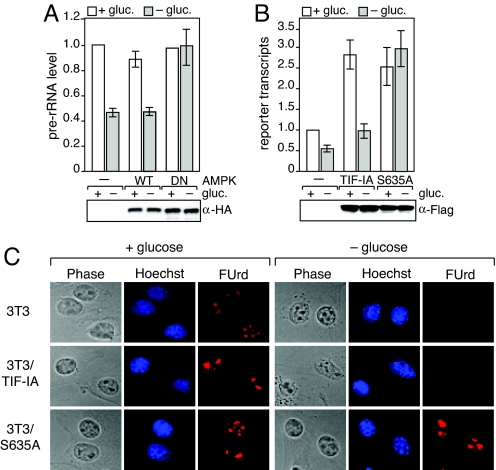Fig. 4.
AMPK-dependent phosphorylation of TIF-IA at S635 down-regulates Pol I transcription. (A) Overexpression of a dominant-negative mutant of AMPK (DN) counteracts repression of Pol I transcription under glucose-restriction. (Upper) HEK293T cells expressing HA-AMPK/WT or HA-AMPK/DN were cultured for 6 h in the presence (white bars) or absence (gray bars) of glucose. Left bars represent values from mock-transfected cells. Pre-rRNA levels were determined by RT-qPCR and normalized to β-actin mRNA. (Lower) The immunoblot shows equal expression levels of HA-AMPK/WT and HA-AMPK/DN. (B) Overexpression of TIF-IAS635A prevents down-regulation of Pol I transcription upon glucose-deprivation. HEK293T cells were transfected with the rDNA reporter pHrP2-BH alone (−) or were cotransfected with expression plasmids encoding Fl-TIF-IA (TIF-IA) or Fl-TIF-IAS635A (S635A). Cells were cultured in glucose-rich medium (white bars) or glucose-free-medium for 6 h before harvesting (gray bars). The graph represents the level of reporter transcripts normalized to β-actin mRNA as determined by RT-qPCR in three independent experiments. (C) TIF-IAS635A rescues rRNA synthesis in glucose-deprived cells. Mock-infected NIH 3T3 cells and cells stably expressing Fl-TIF-IA or Fl-TIF-IAS635A were cultured for 12 h in the presence or absence of glucose. After pulse-labeling with FUrd, nascent RNA was visualized by indirect immunofluorescence with α-BrU antibodies.

